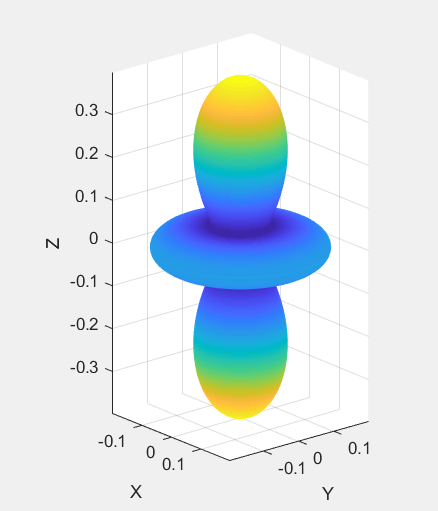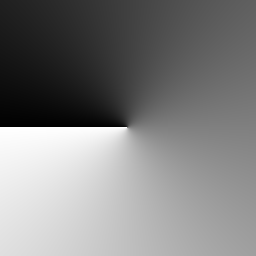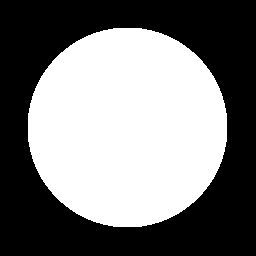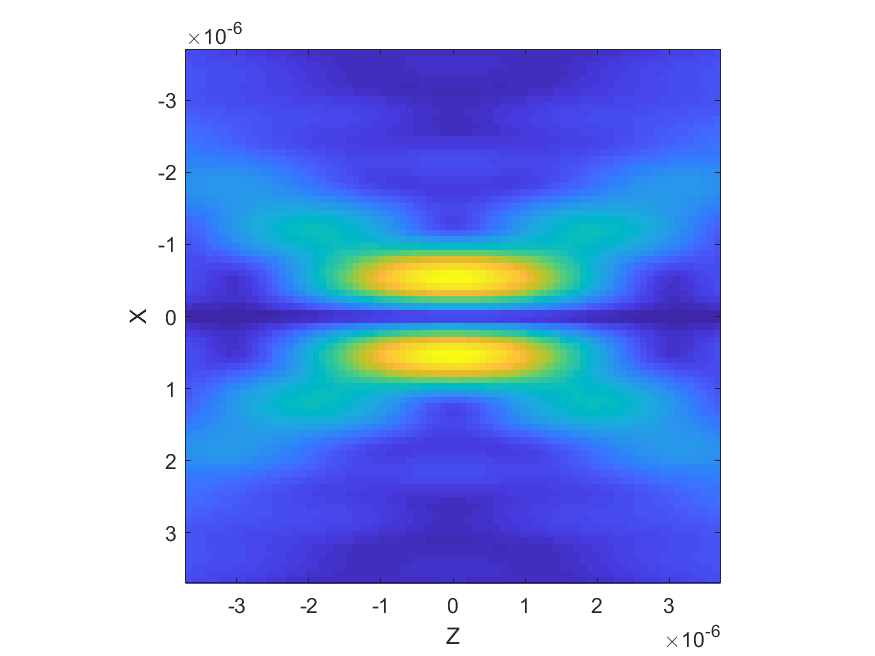Creating a custom beam¶
There are multiple ways to create your own beam in the toolbox. If your
beam can be described as a mixture of other beams already in the
toolbox, you can create the beam by simply adding these beams, see the
combining beams page. If you already have the beam
shape coefficients, the easiest way is to create a new instance of
ott.Bsc. If you don’t know the coefficients but you know the near-
or far-field representation of the beam then you can use the static
functions in ott.BscPointmatch.
A more complicated way to create your own beam is to create your own
class which inherits either from ott.Bsc or ott.BscPointmatch.
This offers greater flexibility and allows you to easily add additional
checks on user input.
Using ott.Bsc directly¶
The ott.Bsc class can be instantiated with arrays of the beam shape
coefficients, this can be useful if you want to create a beam with
particular multipole components or if you are using another method to
calculate the beam shape coefficients. For example, to create a incoming
beam with only quadrapole coefficients:
a = [0, 0, 0, 0, 1, 0, 0, 0]; % [3 dipole, 5 quadrapole]
b = 1i * a;
basis = 'incoming';
type = 'incident';
beam = ott.Bsc(a, b, basis, type);
The ott.Bsc object can then be used with Tmatrix objects or for
visualisation of the beam:
figure();
beam.visualiseFarfieldSphere('type', '3dpolar', 'field', 'E2')

Fig. 7 dipole beam visualization¶
Creating a beam with point matching¶
If you don’t know the VSWF expansion of your beam but you are able to
calculate or measure the phase and amplitude in the near-field or
far-field, you can use ott.BscPointmatch or ott.BscPmParaxial.
ott.BscPointmatch contains two static methods for calculating the
beam shape coefficients from the near-fields or far-fields.
ott.BscPmParaxial uses the far-field method from
ott.BscPointmatch and provides the code to calculate the far-field
coordinates for a 2-D image of the fields at the back focal plane of the
objective.
ott.BscPmParaxial in far-field¶
This class can be used to create beam shape coefficients from images at the back-aperture of the microscope objective. For this example, we will use the following images for the phase and amplitude:


These images may work better if spatial filtering is applied to remove
higher frequency components from the images, this can be achieved using
imgaussfilt. In this example, we are going to generate a circularly
polarised beam. To do this, we first load our images and assemble them
into a complex E field matrix:
% read, scale and convert to double (might need rgb2gray depending on file)
imPhase = double(imread('phase.png')) ./ 255.0;
imAmplitude = double(imread('amplitude.png')) ./ 255.0;
E = imAmplitude; % x polarisation
E(:, :, 2) = 1i * imAmplitude; % y polarisation
E = E .* exp(1i * 2 * pi * imPhase);
For a vector beam, we could instead use separate images for the x and y
polarisation of each pixel. To use the BscPmParaxial class, we need
to provide the complex far-field matrix, the numerical aperture of the
beam, properties of the beam (such as wavelength and frequency), and a
mapping function describing how the image coordinates are mapped to the
spherical coordinates for the far-field of the beam.
The E-field matrix describes the field at the back aperture of the
objective. The matrix is mapped onto a hemisphere, with a maximum angle
defined by the numerical aperture of the objective. The centre of the
hemisphere corresponds to the centre of the images. The radial
coordinate extends from the centre of the image to the edge of the image
(the corners of the image do not contribute to the beam).
BscPmParaxial supports the following mapping functions
'sintheta'(default) image radius proportional tosin(theta)
'tantheta'image radius proportional totan(theta)
'theta'image radius proportional tothetawherethetais the polar coordinate on the hemisphere.
index_medium = 1.0;
wavelength0= 1064e-9;
omega = 3e8 / wavelength0 * 2 * pi;
NA = -1.0; % sign of NA determines beam direction
Nmax = 30; % higher spatial frequencies require higher NA
beam = ott.BscPmParaxial(NA, E, ...
'index_medium', index_medium, ...
'Nmax', Nmax, ...
'wavelength0', wavelength0, ...
'omega', omega);
beam.basis = 'regular';
figure();
beam.visualise('axis', 'y');

Fig. 8 output beam¶
This method can be slow since the coefficient matrix for point matching
is calculated each time. To speed up the method for multiple beam
calculation, BscPmParaxial supports keeping the coefficient matrix.
beam1 = ott.BscPmParaxial(..., 'keep_coefficient_matrix', true);
beam2 = ott.BscPmParaxial(..., 'beamData', beam1);
Far-field¶
ott.BscPointmatch/bsc_farfield can be used to calculate the beam
shape coefficients from the mode indices, coordinates and E-field. The
resulting BSC can be wrapped in an ott.Bsc object (see above).
% Calculate mode indices
mode_indexes=[1:Nmax*(Nmax+2)].';
[nn,mm]=ott.utils.combined_index(mode_indexes);
% Calculate e_field in theta/phi coordinates
[theta,phi]=ott.utils.angulargrid(2*(Nmax+1),2*(Nmax+1));
e_field = ...;
[a, b] = ott.BscPointmatch.bsc_farfield(nn, mm, e_field(:), theta(:), phi(:));
Near-field¶
ott.BscPointmatch/bsc_focalplane calculates the beam shape
coefficients in a Cartesian coordinate system centred around the focal
plane. To use the method, you must specify the mode indices, field
locations and field vectors in Cartesian coordinates.
% Calculate mode indices
mode_indexes=[1:Nmax*(Nmax+2)].';
[nn,mm]=ott.utils.combined_index(mode_indexes);
% Calculate e_field
[xx, yy, zz] = meshgrid(linspace(-1, 1), linspace(-1, 1), linspace(-1, 1));
[r, theta, phi] = ott.utils.xyz2rtp(xx(:), yy(:), zz(:));
kr = r .* 2 * pi / lambda;
e_field = [Ex(:); Ey(:); Ez(:)];
[a, b] = ott.BscPointmatch.bsc_focalplane(nn, mm, e_field, kr, theta, phi);
Custom ott.BscPointmatch class¶
Although the bsc_focalplane and bsc_pointmatch functions can be
used directly, their use is rather cumbersome for regular use. In order
to offer a simplified interface for these objects you can inherit from
ott.BscPointmatch. This allows you to define all the methods needed
to create the beam within the class, directly set the beam shape
coefficients and provide a user interface which provides only physically
motivated parameters.
In this section we will go through an example of creating a
point-matching method for annular beams. For other examples, look at the
ott.BscPm* class implementations.
All beam classes should inherit from ott.Bsc. Point-matching beams
should implement from ott.BscPointmatch which inherits from
ott.Bsc. For our annular class we inherit from
ott.BscPointmatch. The outline for our class is shown bellow:
classdef BscPmAnnular < ott.BscPointmatch
% Documentation...
properties (SetAccess=protected)
% Beam properties...
end
methods (Static)
% Methods which can't access properties...
end
methods
% Methods which can access properties
end
end
We declare the properties as SetAccess=protected, this means that
the properties can only be set by functions defined in the class method
blocks. For annular beams, we define one property, the numerical
aperture describing the inner and outer radius of the annular.
properties (SetAccess=protected)
NA % Numerical aperture [r1, r2]
end
To calculate the beam profile, we will implement a static method which takes as input the two NA and outputs zeros or ones for the amplitude of the beam:
methods (Static)
function im = generatePattern(r1, r2)
[xx, yy] = meshgrid(linspace(-1, 1), linspace(-1, 1));
rr = sqrt(xx.^2 + yy.^2);
im = double(rr > r1 & rr < r2);
end
end
The main method the user will use to interact with the beam is the
constructor. The constructor will include the numerical aperture and
optional named arguments. We use an inputParser to handle the named
arguments. For the beam wavenumber, we can use the
ott.Bsc/parser_k_medium function.
methods
function beam = BscPmAnnular(NA, varargin)
% Call base class constructor
beam = beam@ott.BscPointmatch();
p = inputParser();
p.addParameter('Nmax', 30);
% Parameters for frequency and wavenumber
p.addParameter('omega', 2*pi);
p.addParameter('wavelength0', 1);
p.addParameter('k_medium', []);
p.addParameter('index_medium', []);
p.addParameter('wavelength_medium', []);
p.parse(varargin{:});
% Store/get parameters
Nmax = p.Results.Nmax;
beam.k_medium = ott.Bsc.parser_k_medium(p, 2*pi);
beam.omega = p.Results.omega;
beam.NA = NA;
if isempty(p.Results.index_medium)
nMedium = 1.0;
else
nMedium = p.Results.index_medium;
end
% Calculate the radius from NA
NAonm = NA/nMedium;
% Calculate the pattern
im = beam.generatePattern(NAonm(1), NAonm(2));
% Calculate the coordinates in the far-field
[xx, yy] = meshgrid(linspace(-1, 1), linspace(-1, 1));
rr = sqrt(xx.^2 + yy.^2);
phi = atan2(yy, xx);
theta = asin(rr);
% Remove points outside NA=1
phi = phi(rr < 1);
theta = theta(rr < 1);
im = im(rr < 1);
% Transform im into e_field
Et = sign(cos(theta)).*cos(phi).*im;
Ep = -sin(phi).*im;
e_field=[Et(:); Ep(:)];
% Calculate mode indices
mode_indexes=[1:Nmax*(Nmax+2)].';
[nn,mm]=ott.utils.combined_index(mode_indexes);
% Calculate BSC
[beam.a, beam.b] = ott.BscPointmatch.bsc_farfield(nn, mm, e_field(:), theta(:), phi(:));
% Set other BSC properties
beam.type = 'incident';
beam.basis = 'regular';
end
end
This class doesn’t implement exactly the same functionality as the
ott.BscPmAnnular class, but it shows how a class could be
implemented to wrap the bsc_farfield method.
Full class definition
classdef BscPmAnnular < ott.BscPointmatch
% Documentation...
properties (SetAccess=protected)
NA % Numerical aperture [r1, r2]
end
methods (Static)
function im = generatePattern(r1, r2)
[xx, yy] = meshgrid(linspace(-1, 1), linspace(-1, 1));
rr = sqrt(xx.^2 + yy.^2);
im = double(rr > r1 & rr < r2);
end
end
methods
function beam = BscPmAnnular(NA, varargin)
% Call base class constructor
beam = beam@ott.BscPointmatch();
p = inputParser();
p.addParameter('Nmax', 20);
% Parameters for frequency and wavenumber
p.addParameter('omega', 2*pi);
p.addParameter('wavelength0', 1);
p.addParameter('k_medium', []);
p.addParameter('index_medium', []);
p.addParameter('wavelength_medium', []);
p.parse(varargin{:});
% Store/get parameters
Nmax = p.Results.Nmax;
beam.k_medium = ott.Bsc.parser_k_medium(p, 2*pi);
beam.omega = p.Results.omega;
beam.NA = NA;
if isempty(p.Results.index_medium)
nMedium = 1.0;
else
nMedium = p.Results.index_medium;
end
% Calculate the radius from NA
NAonm = NA/nMedium;
% Calculate the pattern
im = beam.generatePattern(NAonm(1), NAonm(2));
% Calculate the coordinates in the far-field
[xx, yy] = meshgrid(linspace(-1, 1), linspace(-1, 1));
rr = sqrt(xx.^2 + yy.^2);
phi = atan2(yy, xx);
theta = asin(rr);
% Remove points outside NA=1
phi = phi(rr < 1);
theta = theta(rr < 1);
im = im(rr < 1);
% Transform im into e_field
Et = sign(cos(theta)).*cos(phi).*im;
Ep = -sin(phi).*im;
e_field=[Et(:); Ep(:)];
% Calculate mode indices
mode_indexes=[1:Nmax*(Nmax+2)].';
[nn,mm]=ott.utils.combined_index(mode_indexes);
% Calculate BSC
[beam.a, beam.b] = ott.BscPointmatch.bsc_farfield(nn, mm, e_field(:), theta(:), phi(:));
% Set other BSC properties
beam.type = 'incident';
beam.basis = 'regular';
end
end
end
Creating a custom Bsc class¶
For other beam shape coefficient definitions, it is possible to create a
custom class which inherits from ott.Bsc. The implemention for this
class will be very similar to the BscPmAnnular class shown above.
For examples, see ott.BscBessel and ott.BscPlane.
classdef BscCustomClass < ott.Bsc
% Documentation...
properties (SetAccess=protected)
% Beam properties...
end
methods (Static)
% Methods which can't access properties...
end
methods
% Methods which can access properties
function beam = BscCustomClass()
% Call the base class constructor
beam = beam@ott.Bsc();
% Implementation...
end
end
end